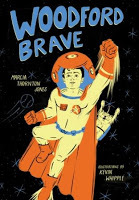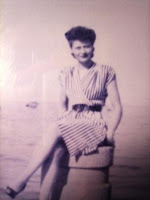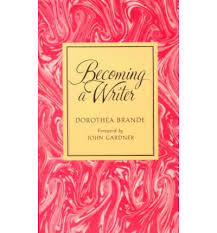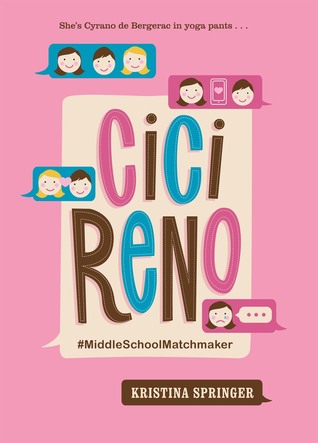Marcia Thornton Jones's Blog, page 152
May 10, 2016
Story TimeBy Marcia Thornton JonesWhen writing WOODFORD B...
 Story Time
Story TimeBy Marcia Thornton Jones
When writing WOODFORD BRAVE, I wanted to show a small town in 1943. Following are a few questions I asked as I researched and wrote WOODFORD BRAVE, along with examples that appear in the book.
· What items does Cory naturally interact with in his world?
I laid my comic book on the nightstand, smoothing the bent bottom corner before turning out the light. The air was thick and my sheets were soggy with sweat in no time. I parted the blackout curtains and moved the rocks lining my windowsill so I could lift out the screen…
· What ‘things’ would a kid notice?
My next door neighbor, Mrs. Springgate sat on her porch, her white hair flopping with every flutter of the cardboard fan in her hand. She was probably getting snookered on beer again. It was hard to tell since beer cans were rationed and she had switched to drinking from glass jars…
Mom was working in her Victory Garden, staking up the tomatoes. Growing vegetables was never going to help us win the war, no matter what Mrs. Roosevelt said. There was no way a bombardment of tomatoes and squash could stop Hitler or his evil spies.
· What music was prevalent?
The music of Glenn Miller’s Orchestra floated through the screen door, the trumpet’s brass marching over the string.
· What might be displayed in stores?
Mr. Franklin had plastered the windows with posters advertising defense saving stamps, war bonds, and the government’s price control order…Mr. Franklin looked over the drug counter at us. Ever since Aidan and I knocked down an entire display of citrate of magnesia, he always watched to make sure we weren’t goofing off when we came into his store. I was extra-careful to walk around the pyramid of God Medal Flour and Quaker Oats that he’d built by the front door.
· What fashions were indicative of the times?
 A cluster of girls wearing high heels went inside. One of them had tried to draw a line down the back of her leg to make it look like she was wearing stockings, but the line was crooked…A trio of girls came in wearing cherry rouge and platform shoes. Navy boys wearing caps cocked to one side whistled through their teeth.
A cluster of girls wearing high heels went inside. One of them had tried to draw a line down the back of her leg to make it look like she was wearing stockings, but the line was crooked…A trio of girls came in wearing cherry rouge and platform shoes. Navy boys wearing caps cocked to one side whistled through their teeth.Details that conveyed 1943 were easy to find because so much of what I researched seemed romantically unique—especially when I talked to my mom about what it was like to come of age in the midst of World War II—and how she met that handsome young sailor that she eventually married!
 But now I’m playing around with a story idea set in early 1970s, and I’m finding it more difficult to weave in details that anchor the story in time and place. I think it’s because I lived those times, so nothing seems unique at all. At least, not to me.
But now I’m playing around with a story idea set in early 1970s, and I’m finding it more difficult to weave in details that anchor the story in time and place. I think it’s because I lived those times, so nothing seems unique at all. At least, not to me.Maybe readers could help! It would be really groovy…far out...cool… if you told me in the comment section what you think of in response to the following five questions!
1. What early 1970s items might characters naturally interact with? 2. What ‘things’ would a 1970s teen notice?3. What songs, musicians, and bands defined the early 1970s?4. What hot items in the early 1970s might be displayed in stores?5. What were the must-have fashions of the early 1970s?
While you’re at it, why not use these questions to brainstorm details for your own story in order to naturally anchor your scenes in time and place?
Right on…er…I mean…Write on!
Published on May 10, 2016 06:44
May 8, 2016
Time Is Relative by Jane Kelley
Time. Oh what tricks it plays. And we writers exploit them, if we can.
Manipulating those minutes on the page is a skill I struggle with. Sometimes I simply forget that I can be free to jump to a new moment. Sometimes I forget to take the time (so to speak) to describe events. We have to choose whether to be fast or slow.
We've heard Einstein's quote about how a minute seems different if one is suffering or savoring.
“Put your hand on a hot stove for a minute, and it seems like an hour. Sit with a pretty girl for an hour, and it seems like a minute. THAT'S relativity.”
But that explanation is more like what fiction does than physics.
It's our job to make those different kinds of experiences work for our stories.
We can't completely ignore the ticking clock; that's the reality of our lives. Our own hearts beat at that rate. But we also need to forget that clock. The reader wants to escape from his or her time. Isn't that one of the measures of a story teller's success? To transcend?

Manipulating those minutes on the page is a skill I struggle with. Sometimes I simply forget that I can be free to jump to a new moment. Sometimes I forget to take the time (so to speak) to describe events. We have to choose whether to be fast or slow.
We've heard Einstein's quote about how a minute seems different if one is suffering or savoring.
“Put your hand on a hot stove for a minute, and it seems like an hour. Sit with a pretty girl for an hour, and it seems like a minute. THAT'S relativity.”
But that explanation is more like what fiction does than physics.
It's our job to make those different kinds of experiences work for our stories.
We can't completely ignore the ticking clock; that's the reality of our lives. Our own hearts beat at that rate. But we also need to forget that clock. The reader wants to escape from his or her time. Isn't that one of the measures of a story teller's success? To transcend?

Published on May 08, 2016 05:00
May 3, 2016
On Finding Time to Write
 Once upon a time I thought in order to write a book I needed big chunks of time – at least a couple of consecutive hours. Not the 15 minute snatches I was able to grab between diapers and soccer practice and groceries.I thought I needed other things, too, like a room of my own, with a door I could close. Quiet time. The right kind of computer. Hot chocolate. And on and on.The truth is, I didn’t need any of those things as I set forth on my journey toward Malcolm Gladwell’s 10,000 hours. Those ideas were merely obstacles I put in my own way – or as Steven Pressfield, author of The War of Art, would say, “Resistance.”
Once upon a time I thought in order to write a book I needed big chunks of time – at least a couple of consecutive hours. Not the 15 minute snatches I was able to grab between diapers and soccer practice and groceries.I thought I needed other things, too, like a room of my own, with a door I could close. Quiet time. The right kind of computer. Hot chocolate. And on and on.The truth is, I didn’t need any of those things as I set forth on my journey toward Malcolm Gladwell’s 10,000 hours. Those ideas were merely obstacles I put in my own way – or as Steven Pressfield, author of The War of Art, would say, “Resistance.”
 In order to overcome this Resistance, I had to retrain my brain. I turned first to Dorothea Brande’s Becoming a Writer for help on the time factor – after completing her program, now I can access my story any hour of the day. And if all I’ve got is 15 minutes (or 5), I can put a few paragraphs in place, often entire scenes.More recently (2015), I participated in a 12 week small group in which we worked through Julia Cameron's The Artist's Way program. Morning pages and artist's dates and all the digging into and nurturing of my artist-self has made my writing time sacred and essential. Writing is spiritual practice for me – a way to love the world and feel connected to it. How can I NOT make time for that?In practical terms, I do write every day. Most often, in the mornings, when the house is quiet. I love the discipline of writing a poem a day. I love how by the end of one week I'll have 7 poems, and by the end of amonth I'll have 30.Also, when I am writing a novel, what works for me is to block off a 6 week period on the calendar. I look really closely to determine days I'm likely to be busy with other events and family stuff, and then I make a commitment: 2,000 words a day (or whatever number is doable/necessary – some of my books have been written on 500 words a day) – except on those days I know from the get-go will be impossible – school visit days or family travel days or going to the doctor days. It's like planning for success. Because, really, what is more deflating than setting a goal like that, and then that busy day comes along, and you only have time for 200 words? It can be tempting to throw over the whole plan! Instead, be honest from the start. Stretch, but try not to overreach. And then, stay the course. It's only six weeks. Having that cap makes it a whole lot easier not to become derailed. When that lunch invitation comes in, I can say “no,” and then schedule it for after the writing block is done. Six weeks is a blink! So, so temporary. Not FOREVER. And if the friend who invited me to lunch can't respect that, then maybe I need a new friend.
In order to overcome this Resistance, I had to retrain my brain. I turned first to Dorothea Brande’s Becoming a Writer for help on the time factor – after completing her program, now I can access my story any hour of the day. And if all I’ve got is 15 minutes (or 5), I can put a few paragraphs in place, often entire scenes.More recently (2015), I participated in a 12 week small group in which we worked through Julia Cameron's The Artist's Way program. Morning pages and artist's dates and all the digging into and nurturing of my artist-self has made my writing time sacred and essential. Writing is spiritual practice for me – a way to love the world and feel connected to it. How can I NOT make time for that?In practical terms, I do write every day. Most often, in the mornings, when the house is quiet. I love the discipline of writing a poem a day. I love how by the end of one week I'll have 7 poems, and by the end of amonth I'll have 30.Also, when I am writing a novel, what works for me is to block off a 6 week period on the calendar. I look really closely to determine days I'm likely to be busy with other events and family stuff, and then I make a commitment: 2,000 words a day (or whatever number is doable/necessary – some of my books have been written on 500 words a day) – except on those days I know from the get-go will be impossible – school visit days or family travel days or going to the doctor days. It's like planning for success. Because, really, what is more deflating than setting a goal like that, and then that busy day comes along, and you only have time for 200 words? It can be tempting to throw over the whole plan! Instead, be honest from the start. Stretch, but try not to overreach. And then, stay the course. It's only six weeks. Having that cap makes it a whole lot easier not to become derailed. When that lunch invitation comes in, I can say “no,” and then schedule it for after the writing block is done. Six weeks is a blink! So, so temporary. Not FOREVER. And if the friend who invited me to lunch can't respect that, then maybe I need a new friend.
 Mostly I find the writing lifestyle demands I be a good friend to MYSELF. I'm a much happier person when I'm writing. I NEED to write. It's what makes my life meaningful, it's the place where I feel most myself. Writing every day and setting reasonable goals is a way to treat myself like a precious object. Abundance is borne of that kind of attention. The words are there. The hours are there. Won't you seize them?-------------------------------Irene Latham is the award winning author of two novels for children LEAVING GEE'S BEND and DON'T FEED THE BOY. She also serves as poetry editor for Birmingham Arts Journal and has published three volumes of poetry for adults. Her current focus is on poetry for children with the 2014 release of DEAR WANDERING WILDEBEEST, which was named an SCBWI Lee Bennett Hopkins Poetry Award Honor book, and two 2016 titles: FRESH DELICIOUS and WHEN THE SUN SHINES ON ANTARCTICA. In between writing, she is currently working on accumulating 10,000 hours on the cello.
Mostly I find the writing lifestyle demands I be a good friend to MYSELF. I'm a much happier person when I'm writing. I NEED to write. It's what makes my life meaningful, it's the place where I feel most myself. Writing every day and setting reasonable goals is a way to treat myself like a precious object. Abundance is borne of that kind of attention. The words are there. The hours are there. Won't you seize them?-------------------------------Irene Latham is the award winning author of two novels for children LEAVING GEE'S BEND and DON'T FEED THE BOY. She also serves as poetry editor for Birmingham Arts Journal and has published three volumes of poetry for adults. Her current focus is on poetry for children with the 2014 release of DEAR WANDERING WILDEBEEST, which was named an SCBWI Lee Bennett Hopkins Poetry Award Honor book, and two 2016 titles: FRESH DELICIOUS and WHEN THE SUN SHINES ON ANTARCTICA. In between writing, she is currently working on accumulating 10,000 hours on the cello.
Published on May 03, 2016 03:30
May 2, 2016
Time by Ann Haywood Leal
Many of my writer and creative-type friends have just drifted into their REM states when I get up in the morning. The sun hasn’t even opened one eye, but I stumble down the stairs to feed my cats and open my laptop.

It’s for a pretty simple reason, really. Time.
I’ve been doing this for several years now. I guess I’m trying to stomp on the popular refrain of busy people: There are only 24 hours in each day. Here’s my trick. Getting up before everyone except my cats adds minutes and hours to my day. No, I don’t have a plutonium-filled DeLorean in my garage (unfortunately!), but I am adding minutes and hours to my writing day.
It’s the way I have to do it. I teach first grade, and there’s something I learned forever ago from my mom who taught six and seven-year-olds before me: they take more energy than you thought existed in your mind and body. It’s a wonderful, satisfying type of exhaustion, but it leaves very little for the end of my day.
 But if I didn’t carve out that writing time, I’d be a different kind of exhausted – the cranky, shuffle-around-mumbling kind.
But if I didn’t carve out that writing time, I’d be a different kind of exhausted – the cranky, shuffle-around-mumbling kind.
And it’s true, unless you are meeting Dr. Emmett Brown and Marty McFly in the parking lot of the Twin Pines Mall, you’re going to have to give up something to create your own writing minutes and hours. It might be sleep or a kind-of-favorite TV show. It could be your surfing time (and I don’t mean on the beaches of sunny California).
It might be a little uncomfortable at first, like a little pinch or a scrape-your-knee-and-need-your-mother-to-blow-on-it way, but you can push through it. You should push through it.
Because when you do, you are left with a book . . . or a poem . . . or a song. And that’s worth every bit of it.


It’s for a pretty simple reason, really. Time.
I’ve been doing this for several years now. I guess I’m trying to stomp on the popular refrain of busy people: There are only 24 hours in each day. Here’s my trick. Getting up before everyone except my cats adds minutes and hours to my day. No, I don’t have a plutonium-filled DeLorean in my garage (unfortunately!), but I am adding minutes and hours to my writing day.

It’s the way I have to do it. I teach first grade, and there’s something I learned forever ago from my mom who taught six and seven-year-olds before me: they take more energy than you thought existed in your mind and body. It’s a wonderful, satisfying type of exhaustion, but it leaves very little for the end of my day.
 But if I didn’t carve out that writing time, I’d be a different kind of exhausted – the cranky, shuffle-around-mumbling kind.
But if I didn’t carve out that writing time, I’d be a different kind of exhausted – the cranky, shuffle-around-mumbling kind. And it’s true, unless you are meeting Dr. Emmett Brown and Marty McFly in the parking lot of the Twin Pines Mall, you’re going to have to give up something to create your own writing minutes and hours. It might be sleep or a kind-of-favorite TV show. It could be your surfing time (and I don’t mean on the beaches of sunny California).
It might be a little uncomfortable at first, like a little pinch or a scrape-your-knee-and-need-your-mother-to-blow-on-it way, but you can push through it. You should push through it.
Because when you do, you are left with a book . . . or a poem . . . or a song. And that’s worth every bit of it.

Published on May 02, 2016 04:07
April 28, 2016
My Own Attempt at Middle School Matchmaking - Guest Post by Kristina Springer
When the kids at school need advice in my newest book, Cici Reno #MiddleSchoolMatchmaker, Cici is the one they trust. She’s cool, she’s funny, AND she’s enlightened (thanks to yoga classes at her mom’s studio). So when her pretty best friend Aggie is too shy to speak to the boy she’s crushing on, Cici goes online and does the talking for her, Cyrano de Bergerac style.
 There’s a seed of truth in all of my books. Often times I’ll be reflecting on something that happened when I was the age of my characters and then spin it into a fun tale. When I was in 7th grade I took my own stab at middle school matchmaking. Back then, one of my close friends was majorly crushing on a boy from my brother’s soccer team. She said she really wanted to go on a date with him but was too shy to approach him herself. Well, we didn’t have cell phones or the Internet back then so there was no sending him a tweet or an e-mail. Instead we came up with a plan where I telephoned him, pretending to be her, and convinced him to meet me (really her) for a movie. The date was set and one Saturday afternoon we all showed up at the theater for the “date.” My job was just to support her and give her a shove into the theater to meet him and then go hang out and wait until she came back out. She was supposed to take a seat next to him so they could watch the movie together. But that’s not exactly what happened. She sorta panicked and dragged me into the theater with her. And then she didn’t say a single word to the guy! She was totally terrified. And she wouldn’t let me talk to him either. Instead, the two of us sat on one side of the aisle and the guy literally sat on the opposite side of the aisle. For the entire movie. It was so AWKWARD! And I felt really bad for him. When the movie ended, he left the theater and we waited to make sure he was good and gone before we exited. They never did discuss this disastrous “date” and we all moved on with our lives. That is, until I dredged up this memory for a scene in Cici Reno #MiddleSchoolMatchmaker where Cici’s shy bff Aggie has to meet the boy she’s crushing on for a movie date. Only things go quite differently in fiction.
There’s a seed of truth in all of my books. Often times I’ll be reflecting on something that happened when I was the age of my characters and then spin it into a fun tale. When I was in 7th grade I took my own stab at middle school matchmaking. Back then, one of my close friends was majorly crushing on a boy from my brother’s soccer team. She said she really wanted to go on a date with him but was too shy to approach him herself. Well, we didn’t have cell phones or the Internet back then so there was no sending him a tweet or an e-mail. Instead we came up with a plan where I telephoned him, pretending to be her, and convinced him to meet me (really her) for a movie. The date was set and one Saturday afternoon we all showed up at the theater for the “date.” My job was just to support her and give her a shove into the theater to meet him and then go hang out and wait until she came back out. She was supposed to take a seat next to him so they could watch the movie together. But that’s not exactly what happened. She sorta panicked and dragged me into the theater with her. And then she didn’t say a single word to the guy! She was totally terrified. And she wouldn’t let me talk to him either. Instead, the two of us sat on one side of the aisle and the guy literally sat on the opposite side of the aisle. For the entire movie. It was so AWKWARD! And I felt really bad for him. When the movie ended, he left the theater and we waited to make sure he was good and gone before we exited. They never did discuss this disastrous “date” and we all moved on with our lives. That is, until I dredged up this memory for a scene in Cici Reno #MiddleSchoolMatchmaker where Cici’s shy bff Aggie has to meet the boy she’s crushing on for a movie date. Only things go quite differently in fiction. Grab a copy of Cici Reno #MiddleSchoolMatchmaker from any of these outlets to find out what happens:
B&N: http://www.barnesandnoble.com/w/cici-reno-middleschoolmatchmaker-kristina-springer/1123053519?ean=9781454917519
Amazon: http://www.amazon.com/Cici-Reno-MiddleSchoolMatchmaker-Yoga-Girls/dp/1454917512?ie=UTF8&psc=1&redirect=true&ref_=ox_sc_act_title_1&smid=ATVPDKIKX0DER
Indiebound: http://www.indiebound.org/book/9781454917519
Kristina Springer
Find me on:Twitter , Facebook, or Instagramwww.kristinaspringer.com
Published on April 28, 2016 05:00
April 25, 2016
BRAINSTORMING ONCE THE BOOK IS DONE (HOLLY SCHINDLER)
Brainstorming and generating new ideas doesn't end after the final line is typed in your book. It doesn't end once global edits are completed with your editor. It isn't even done once the cover is revealed, the copyedits all polished off.
You just keep on brainstorming new ideas--for promotion, spreading word about your book.
One of my latest brainstorming sessions allowed me to put together the trailer for my upcoming YA, SPARK (due out May 17). I had a ton of fun with this one:
You just keep on brainstorming new ideas--for promotion, spreading word about your book.
One of my latest brainstorming sessions allowed me to put together the trailer for my upcoming YA, SPARK (due out May 17). I had a ton of fun with this one:
Published on April 25, 2016 05:00
April 23, 2016
Smack Dab in the Classroom: Foster the Extraordinary Child, by Dia Calhoun
Last week at the Central Teen Lit Festival in Bend, Oregon, I met an extraordinary twelve-year old boy. He brought three novels he'd written--perhaps 150 pages or more each. His mechanics--handling of dialogue, quotation marks, paragraphing, a table of contents--were better than many beginning adult writers. The thoroughness was amazing.
Amazing, too, was the imaginative content. He mixed Star Wars, King Arthur--one character was J.M. Barrie, author of Peter Pan. What richness! I wondered when he did all of this work. Outside of school? In school?
And I thought back to my own early education and how boring it was. How unchallenged I was. I remember the dreaded "reading circles," where we all sat and read one sentence at a time. I would count ahead the number of sentences to see when I would read, stick my thumb on the page to be ready for my turn, and then eagerly read on ahead to find out what was happening in the story.
We need to do more to foster and encourage children who excel in imagination. So today I urge all teachers and school districts to foster the talent of extraordinary children like the boy I met in Bend.
Amazing, too, was the imaginative content. He mixed Star Wars, King Arthur--one character was J.M. Barrie, author of Peter Pan. What richness! I wondered when he did all of this work. Outside of school? In school?
And I thought back to my own early education and how boring it was. How unchallenged I was. I remember the dreaded "reading circles," where we all sat and read one sentence at a time. I would count ahead the number of sentences to see when I would read, stick my thumb on the page to be ready for my turn, and then eagerly read on ahead to find out what was happening in the story.
We need to do more to foster and encourage children who excel in imagination. So today I urge all teachers and school districts to foster the talent of extraordinary children like the boy I met in Bend.
Published on April 23, 2016 13:58
April 21, 2016
When Characters Step Out of the Mist by Laurie Calkhoven
Every writer and illustrator I know uses tools for brainstorming—freewriting, idea clusters, long walks in the country, etc. One of the most productive for me is meditation.
I’ve been meditating off and on since I was a senior high school. It was natural for me to use meditation as a tool when I started writing. It helped to quiet the shallow thoughts swirling around in my overactive brain. After 15-20 minutes of following my breath, my mind was quieter and open to ideas. I could let my subconscious out to play. The freewrites and idea clusters I did afterward were both deeper and more productive.
Along the way I discovered that meditation is a great way to get to know my characters. I started doing visualizations at the end of my meditations to envision my characters walking toward me, stepping out of a mist, ready to tell me a story or a secret. I developed a series questions and let them surprise me with their answers. Most of those questions and answers don’t end up in the finished novel, but they inform the story and add a richness and depth to the characters that wasn’t there before.
 But sometimes those secrets do end up in the book. Asking Daniel what he had in his pockets (clay marbles), led to the opening and closing scenes of DANIEL AT THE SIEGE OF BOSTON. Will’s treasure box and its contents appear in WILL AT THE BATTLE OF GETTYSBURG, and Michael’s strong memory involving a parent is his driving force in MICHAEL AT THE INVASION OF FRANCE. These small and big details add a texture to the story that wouldn’t be there otherwise.
But sometimes those secrets do end up in the book. Asking Daniel what he had in his pockets (clay marbles), led to the opening and closing scenes of DANIEL AT THE SIEGE OF BOSTON. Will’s treasure box and its contents appear in WILL AT THE BATTLE OF GETTYSBURG, and Michael’s strong memory involving a parent is his driving force in MICHAEL AT THE INVASION OF FRANCE. These small and big details add a texture to the story that wouldn’t be there otherwise.
The element of surprise helps. If I know ahead of time about what I’m going to be writing about, then I tend to keep coming back to that in meditation. So I surprise myself. For those or those of you interested in trying this, I suggest having a number of questions on index cards face down on your desk. When you’ve finish your meditation and your character is present, turn a card over and begin to write. Keep your hand moving and let whatever bubbles up out onto the page.
Meditation didn’t just lead to better-developed characters. I found those visualizations so helpful that I developed others to help me conjure scenes, to brainstorm plot elements, and to solve story problems. Today I couldn’t imagine writing without meditation. I’ve even created a workshop that has proven to be as helpful to other writers and illustrators as it has been for me.
But you don’t need a workshop, really. You just need a comfortable seat, a notebook, and a pen. Breathe in. Breathe out. Breathe in. Breathe out. Let your characters step out of the mist and tell you something that only they can.
I’ve been meditating off and on since I was a senior high school. It was natural for me to use meditation as a tool when I started writing. It helped to quiet the shallow thoughts swirling around in my overactive brain. After 15-20 minutes of following my breath, my mind was quieter and open to ideas. I could let my subconscious out to play. The freewrites and idea clusters I did afterward were both deeper and more productive.
Along the way I discovered that meditation is a great way to get to know my characters. I started doing visualizations at the end of my meditations to envision my characters walking toward me, stepping out of a mist, ready to tell me a story or a secret. I developed a series questions and let them surprise me with their answers. Most of those questions and answers don’t end up in the finished novel, but they inform the story and add a richness and depth to the characters that wasn’t there before.
 But sometimes those secrets do end up in the book. Asking Daniel what he had in his pockets (clay marbles), led to the opening and closing scenes of DANIEL AT THE SIEGE OF BOSTON. Will’s treasure box and its contents appear in WILL AT THE BATTLE OF GETTYSBURG, and Michael’s strong memory involving a parent is his driving force in MICHAEL AT THE INVASION OF FRANCE. These small and big details add a texture to the story that wouldn’t be there otherwise.
But sometimes those secrets do end up in the book. Asking Daniel what he had in his pockets (clay marbles), led to the opening and closing scenes of DANIEL AT THE SIEGE OF BOSTON. Will’s treasure box and its contents appear in WILL AT THE BATTLE OF GETTYSBURG, and Michael’s strong memory involving a parent is his driving force in MICHAEL AT THE INVASION OF FRANCE. These small and big details add a texture to the story that wouldn’t be there otherwise.The element of surprise helps. If I know ahead of time about what I’m going to be writing about, then I tend to keep coming back to that in meditation. So I surprise myself. For those or those of you interested in trying this, I suggest having a number of questions on index cards face down on your desk. When you’ve finish your meditation and your character is present, turn a card over and begin to write. Keep your hand moving and let whatever bubbles up out onto the page.
Meditation didn’t just lead to better-developed characters. I found those visualizations so helpful that I developed others to help me conjure scenes, to brainstorm plot elements, and to solve story problems. Today I couldn’t imagine writing without meditation. I’ve even created a workshop that has proven to be as helpful to other writers and illustrators as it has been for me.
But you don’t need a workshop, really. You just need a comfortable seat, a notebook, and a pen. Breathe in. Breathe out. Breathe in. Breathe out. Let your characters step out of the mist and tell you something that only they can.
Published on April 21, 2016 23:00
April 18, 2016
My (Doomed) Search for the Best Idea (April theme) by Claudia Mills
On the topic of brainstorming, an author friend says, "You don't want your first idea, you want your best idea." Another writing guru has proclaimed that the writing process has three stages: 1) Think it up; 2) Write it up; 3) Fix it up. He claims that the vast majority of a writer's time should be spent on #1 and #3.
These are most likely excellent tidbits of advice.
The trouble is that they don't seem to work for me.
Case in point: I decided this year that I was going to seek and find not more ideas, but better ideas, not my first idea, but my best idea. I was going to spend a TON of time on "Think it up" before I ever let myself leap into "Write it up."
It was January when I started "thinking it up." I've been thinking ever since, waiting for that best idea to emerge. But it's mid-April now, and still no best idea has appeared.Despite the spring sunshine, despite daffodils, tulips, and redbud in bloom, I'm paralyzed with inertia, pale with depression, as sad a writer as I've ever been.
Because here's the thing. The part of writing that I love best isn't "Think it up," or "Fix it up."It's "Write it up." It just so happens that what I love most is the writing itself. What I've written over the course of the past three-and-a-half months, as I did my so-called thinking, has been precisely nothing. Oh, and you can't "fix up" nothing, either.
So yesterday I decided that I wasn't going to wait a minute longer for my best idea, or for a good idea, or even for a minimally okay idea. I was going to look at my somewhat pitiful list of ideas, pick one of them, and start writing. Never was there such a change in an author's mood in the history of the world. And guess what? As I write, I'm finding a way to make this idea - yes, this one - better and better.
Maybe it will turn out to be my best one yet. Or maybe not. I can't worry about that now. I'm too busy writing.
These are most likely excellent tidbits of advice.
The trouble is that they don't seem to work for me.
Case in point: I decided this year that I was going to seek and find not more ideas, but better ideas, not my first idea, but my best idea. I was going to spend a TON of time on "Think it up" before I ever let myself leap into "Write it up."
It was January when I started "thinking it up." I've been thinking ever since, waiting for that best idea to emerge. But it's mid-April now, and still no best idea has appeared.Despite the spring sunshine, despite daffodils, tulips, and redbud in bloom, I'm paralyzed with inertia, pale with depression, as sad a writer as I've ever been.
Because here's the thing. The part of writing that I love best isn't "Think it up," or "Fix it up."It's "Write it up." It just so happens that what I love most is the writing itself. What I've written over the course of the past three-and-a-half months, as I did my so-called thinking, has been precisely nothing. Oh, and you can't "fix up" nothing, either.
So yesterday I decided that I wasn't going to wait a minute longer for my best idea, or for a good idea, or even for a minimally okay idea. I was going to look at my somewhat pitiful list of ideas, pick one of them, and start writing. Never was there such a change in an author's mood in the history of the world. And guess what? As I write, I'm finding a way to make this idea - yes, this one - better and better.
Maybe it will turn out to be my best one yet. Or maybe not. I can't worry about that now. I'm too busy writing.
Published on April 18, 2016 13:47
April 17, 2016
Brainstorming (April Theme - Sarah Dooley)
My brain, though, is always a storm. There are stories in there, sure. There are character voices. There are streets I want readers to walk down, corners I want them to look around. There are memories I will mine, bits of dialogue waiting to be spoken.
There's also a whole lot of other in there. Work deadlines. Revision deadlines. Publicity commitments. Social commitments. Animals needing tended, bills needing paid, friends needing attended to, stress needing managed, life needing lived. Some days it feels impossible to figure out how to harness the high winds and the coming rain of story.
For me, the trick is to show up at the same time every day. The weather will differ, but as long as I'm there, I have the chance of capturing that first gust of wind, that first turn of phrase, the first few drops of rain that make a mark on an empty page. When the sky seems clear of story, I don't brainstorm about what to write. I write. Sometimes I write about the bills. About the animals. The weather. But if I put words on paper long enough, the wind shifts, and a story blows in.
There's also a whole lot of other in there. Work deadlines. Revision deadlines. Publicity commitments. Social commitments. Animals needing tended, bills needing paid, friends needing attended to, stress needing managed, life needing lived. Some days it feels impossible to figure out how to harness the high winds and the coming rain of story.
For me, the trick is to show up at the same time every day. The weather will differ, but as long as I'm there, I have the chance of capturing that first gust of wind, that first turn of phrase, the first few drops of rain that make a mark on an empty page. When the sky seems clear of story, I don't brainstorm about what to write. I write. Sometimes I write about the bills. About the animals. The weather. But if I put words on paper long enough, the wind shifts, and a story blows in.
Published on April 17, 2016 12:07



